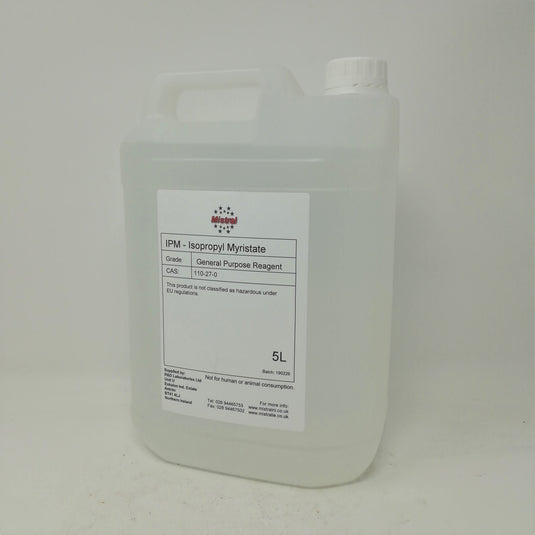Isopropyl Palmitate - IPP
Cosmetic Grade
Propan-2-yl hexadecanoate
Isopropyl hexadecanoate
Isopropyl Palmitate (IPP) is a clear, colourless to pale yellow ester formed by the reaction of isopropyl alcohol and palmitic acid (a fatty acid commonly derived from coconut or palm oil). It is widely used in cosmetic, personal care, and pharmaceutical formulations as an emollient, solvent, and texture enhancer.
Chemical Profile
-
INCI Name: Isopropyl Palmitate
-
CAS Number: 142-91-6
-
Molecular formula: C₁₉H₃₈O₂
-
Appearance: Clear, oily liquid
-
Odour: Slight, characteristic
-
Solubility: Insoluble in water; miscible with oils, esters, alcohols
Key Functions & Benefits
| Function | Description |
|---|---|
| Emollient | Softens and smooths skin by creating a light, non-greasy film |
| Solvent | Dissolves oil-soluble actives and helps deliver them to skin |
| Spreading agent | Improves spreadability of creams, lotions, and oils |
| Texture modifier | Reduces greasy feel of oils and enhances skin feel |
| Carrier oil | Acts as a delivery vehicle for active ingredients in topical formulas |
Common Applications
Cosmetics & Skincare
-
Lotions and creams (light emollient feel)
-
Face serums, moisturizers, sunscreens
-
Makeup removers and cleansing oils
-
Lipsticks and colour cosmetics
Hair Care
-
Conditioners and shine products
-
Adds slip without greasiness
Pharmaceuticals
- Used in dermal preparations and ointments
Other Uses
-
Massage oils
-
Nail polish removers (non-acetone formulas)
-
Industrial formulations (solubiliser for actives)
Formulation & Safety Notes
-
Use level: Typically 2–10%, but can go up to 50% in oils
-
Skin feel: Light, dry, non-tacky
-
Comedogenicity: May clog pores in acne-prone skin (moderate comedogenic rating)
-
Biodegradable and considered safe for cosmetic use (EU/US/Japan)
How IPP Is Used in Perfumery
1. Carrier for Oil-Based Perfumes
-
IPP is an excellent solvent for essential oils and aromatic compounds.
-
It provides a light, dry, non-greasy feel, unlike heavier carriers like mineral oil or castor oil.
-
It helps evenly disperse fragrance and improves spreadability on skin.
Use: Blend 10–30% fragrance oil with 70–90% IPP to create a clear, stable perfume oil.
2. Fixative Base
-
While IPP is not a fixative in the strict chemical sense, it slows evaporation of volatile top notes and enhances longevity.
-
It softens the release profile of sharp or fast-fading notes.
3. Solubilizer in Oil-Soluble Fragrance Systems
-
Ideal for anhydrous perfume applications, such as:
-
Roll-on perfumes
-
Solid perfumes (in wax + ester base)
-
Dry body oils with fragrance
-
4. Sensory Modifier
-
IPP adds a silky, fast-absorbing texture to fragrance blends used in:
-
Massage oils
-
Luxury facial oils
-
Hair serums with fragrance
-
-
Unlike many other carriers, IPP doesn’t feel sticky or overly oily
Blending & Compatibility
-
Miscible with: essential oils, aromatic esters, alcohols, fixed oils
-
Compatible with: other esters (e.g., CCT, IPM), silicones, fatty alcohols
-
Not suitable for alcohol-based perfumes (not soluble in ethanol)
Typical Formula Example – Roll-On Perfume Oil
| Ingredient | % w/w |
|---|---|
| Fragrance oil blend | 20% |
| Isopropyl Palmitate | 78.5% |
| Vitamin E (antioxidant) | 0.5% |
| Optional: dye/tint | q.s. |
-
Mix and bottle in glass roll-on containers.
-
No preservative needed (anhydrous), but keep air-tight.
Notes:
-
Shelf stable; store in cool, dark place
-
Use caution with acne-prone or very oily skin types (mildly comedogenic)
-
Can be used alongside isopropyl myristate (IPM) for faster dry-down
Properties of isopropyl palmitate:
- Cas No: 142-91-6
- Molecular formula: C₁₉H₃₈O₂
- Appearance: Clear, colorless to pale yellow oily liquid
- Odour: Faint, slightly fatty or mild ester-like
-
Molecular weight: 298.50 g/mol
- Acid value: 0.5 max
- Specific gravity: ~0.850–0.855 g/cm³
- Melting Point: ~−4 °C
- Boiling Point: ~230 °C (decomposes)oC
- Flash Point: ~148 °C (closed cup)
- Viscosity: ~8–10 cP
- Insoluble in: Water.
- Soluble in: Most organic solvents
- Refractive index: ~1.434–1.436
- Vapour pressure: 9.35X10-5 mm Hg at 25 C
Soluble In:
-
Non-polar and medium-polar organic solvents
-
Oils and esters (e.g., caprylic/capric triglyceride, mineral oil, castor oil)
-
Silicones (e.g., cyclopentasiloxane, dimethicone)
-
Alcohols (e.g., isopropyl alcohol, benzyl alcohol)
-
Fragrance oils
-
Lipophilic actives and vitamins (e.g., vitamin E)
Insoluble In:
-
Water
-
Glycerin
-
Propylene glycol
-
Short-chain glycols
It cannot form a stable emulsion with water unless emulsifiers are used.
Health & safety
Not a hazardous substance or mixture according to Regulation (EC) No. 1272/2008. This substance is not classified as dangerous according to Directive 67/548/EEC.
PLEASE NOTE: This product is not for human or animal consumption.
